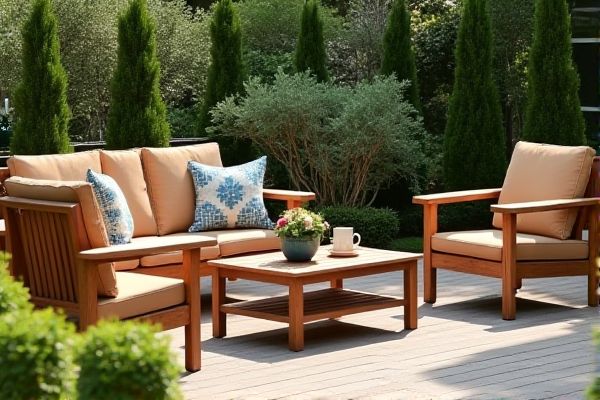
Cedar and teak outdoor furniture offer distinct advantages: cedar is lightweight, affordable, and naturally resistant to insects and decay, while teak is renowned for its exceptional durability, weather resistance, and rich golden color that ages beautifully over time. Explore the rest of this article to determine which wood best suits your outdoor living space and lifestyle.
Table of Comparison
| Feature | Cedar Outdoor Furniture | Teak Outdoor Furniture |
|---|---|---|
| Durability | Moderately durable, resists rot and insects, lasts 10-15 years | Highly durable, naturally resistant to rot, insects, and weather, lasts 20-30 years |
| Maintenance | Requires annual sealing or staining to maintain color and protection | Low maintenance, can be left untreated and will develop a natural silver patina |
| Appearance | Reddish-brown color, smooth grain, warm aesthetic | Golden brown color, straight grain, classic, elegant look |
| Weight | Lightweight and easy to move | Heavy and sturdy |
| Cost | More affordable, budget-friendly option | Expensive, premium choice |
| Weather Resistance | Good resistance but can warp or crack over time without care | Excellent weather resistance, ideal for all climates |
| Environmental Impact | Generally sustainable, often sourced from managed forests | Concerns over deforestation, but FSC-certified options available |
Introduction to Cedar and Teak Outdoor Furniture
Cedar outdoor furniture is prized for its natural resistance to decay, insect damage, and its aromatic qualities, making it a durable and fragrant choice for your garden or patio. Teak furniture boasts a high oil content and dense grain, providing exceptional weather resistance and longevity even in harsh outdoor conditions. Both materials offer unique benefits, with cedar standing out for its affordability and cedar's rich color contrasting with teak's golden hue that ages to a sophisticated silver patina.
Wood Characteristics: Cedar vs Teak
Cedar outdoor furniture features a lightweight, softwood texture with natural resistance to decay, moisture, and insect damage, often displaying a reddish hue and aromatic scent. Teak, a dense hardwood, boasts exceptional durability and high natural oil content that repels water and prevents warping, making it ideal for harsh weather conditions. Both woods offer excellent weather resistance, but teak's strength and longevity surpass cedar, justifying its premium cost for long-term outdoor use.
Durability and Weather Resistance
Cedar outdoor furniture is naturally resistant to rot, insects, and moisture due to its high oil content, making it highly durable in various weather conditions. Teak furniture boasts exceptional durability with dense, oily wood that withstands sun, rain, and humidity, often lasting decades with minimal maintenance. Your choice depends on whether you prefer the lighter, aromatic qualities of cedar or the robust, long-lasting performance of teak for enduring outdoor use.
Maintenance Requirements
Cedar outdoor furniture requires regular sealing or staining to protect against moisture and prevent cracking, while teak furniture naturally contains oils that resist rot and insects, reducing the need for frequent treatments. Both woods benefit from periodic cleaning to maintain their appearance, but teak demands less intensive upkeep, making it ideal for those seeking low-maintenance options. Your choice depends on how much time you want to invest in preserving the furniture's durability and aesthetic appeal.
Aesthetic Appeal and Color Differences
Cedar outdoor furniture features a warm reddish-brown hue that weathers to a charming silver-gray over time, offering a natural and rustic aesthetic. Teak boasts a rich golden-brown color that deepens with age, maintaining a sleek and polished look ideal for sophisticated outdoor settings. Your choice between cedar and teak should consider these distinct color transformations and how they complement your outdoor decor style.
Cost Comparison: Cedar vs Teak
Cedar outdoor furniture is generally more affordable than teak, making it a popular choice for budget-conscious buyers seeking natural wood options. Teak commands a higher price due to its exceptional durability, natural oils that resist weathering, and longer lifespan, often justifying the investment for premium outdoor settings. While cedar may require more frequent maintenance, its cost advantage appeals to those prioritizing initial expenditure over long-term durability.
Environmental Impact and Sustainability
Cedar outdoor furniture is highly regarded for its renewable qualities, as it grows relatively quickly and requires less intensive harvesting compared to teak, which comes from slower-growing tropical hardwood trees often linked to deforestation. Teak's natural oils provide exceptional durability without chemical treatments, but demand for teak has raised concerns about illegal logging and habitat loss. Choosing cedar supports sustainable forestry practices and reduces your environmental footprint, making it a responsible choice for eco-conscious outdoor living.
Insect and Rot Resistance
Cedar outdoor furniture exhibits natural insect-repellent properties and contains oils that resist rot, making it highly durable in moist environments. Teak, enriched with natural silica and oils, provides exceptional resistance to termites, insects, and water damage, often outperforming cedar in longevity. Both woods offer superior rot resistance, but teak's dense grain structure ensures greater protection against decay and pest infestation.
Best Uses and Applications in Outdoor Spaces
Cedar outdoor furniture excels in resistance to rot and insects, making it ideal for damp climates, garden benches, and pergolas where durability is essential. Teak outdoor furniture, prized for its natural oils and dense grain, offers superior longevity and graceful aging, perfect for high-end patio sets and poolside lounges exposed to strong sunlight and frequent moisture. Both woods perform well in outdoor spaces, with cedar favored for rustic aesthetics and affordability, while teak fits luxury settings requiring premium, low-maintenance surfaces.
Conclusion: Which Is Better for Outdoor Furniture?
Teak outdoor furniture offers superior durability and natural resistance to weather, insects, and rot, making it a premium choice for long-lasting outdoor pieces. Cedar provides a lighter, more affordable option with good resistance to decay and a pleasant aroma but requires more regular maintenance to preserve its appearance. Your choice depends on budget and maintenance commitment, with teak being better for investment in longevity and cedar for cost-effective, lightweight outdoor furniture.
 homyna.com
homyna.com